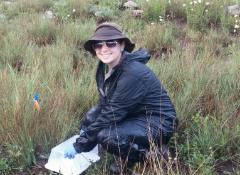Rachel Harrow
Rachel Harrow is pursuing a B.S. in Forestry and a Wildlife Ecology and Management Certificate from Northern Arizona University, and she expects to graduate in May 2016. Rachel has 3 years of experience trapping mammals, reptiles, and amphibians. Experiences growing up camping in Arizona steered Rachel toward natural resource management. Rachel is passionate about forestry and the wildlife management interface, conservation biology, and ecology. She is an active member of Forestry Club, Society of American Foresters, Xi Sigma Pi, and The Wildlife Society. Rachel’s goal is to continue her education and earn her M.S. in Fish and Wildlife Conservation Biology.
Research
Detection Strategies and Habitat Tolerances of the New Mexico Meadow Jumping Mouse
The New Mexico meadow jumping mouse is listed as endangered. Recovery efforts for this species require monitoring and assessments of population size. However, conducting population surveys is difficult with traditional methods because live trapping is associated with risks of trap mortality, zoonotic disease transmission, and a potential for negative bias by trap-shy subjects. An alternative method of detection, collecting footprints with track plates, increases the likelihood of detection, and it reduces stress, risks of mortality, and disease transmission. The objective of Rachel’s research project is to create a rodent track guide for species likely to use track plates designed for jumping mice, so that tracks of the focal species are not misidentified. Co-occurring rodent species at three locations around Flagstaff will be trapped, identified, and printed. A rodent track guide with high-quality fore- and hind-paw prints for each species will be produced. The guide will be used by concurrent projects to detect and monitor natural populations and in future research to better understand life history characteristics and pursue recovery goals for jumping mice.
See Rachel’s poster at NAU’s 2016 CEFNS Undergraduate Research and Design Symposium



